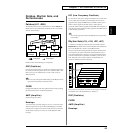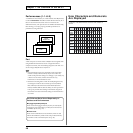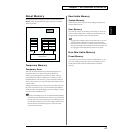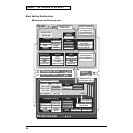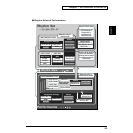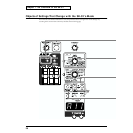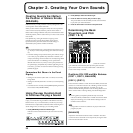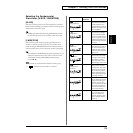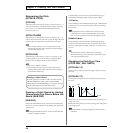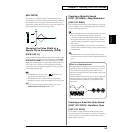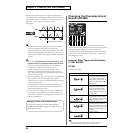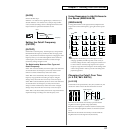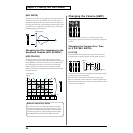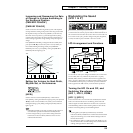
53
Chapter 2. Creating Your Own Sounds
Chapter 2
Selecting the Fundamental
Waveform (WAVE, VARIATION)
[WAVE]
Select the waveform groups on which the synthesizer’s sounds are
based. Each time [WAVE] is pressed, the selected waveform group is
switched in the order shown right.
Holding down [WAVE] and pressing [VARIATION] switches
the waveform groups in the reverse order of that shown right.
[VARIATION]
Each waveform group selected by pressing [WAVE] features a
number of variations, providing you with an even wider sound
palette. Pressing [VARIATION] switches the variations in order of
variation number. Once you have selected a variation, press [EXIT].
By holding down [VARIATION] and pressing [WAVE], you can
switch the variations in the reverse order. You can also select
variations by pressing [VARIATION] and then pressing
[VALUE ▼/▲].
• The number of variations differs with the waveform group.
•“ ” (PWM waveform) includes no variations.
Waveform Group Number of
Variations
Description
(Sawtooth Wave)
12 (1–12) Often used in creating
characteristic synthesizer
sounds. Variation 12 is
constructed from multiple,
detuned, sawtooth waves
layered together.
(Square Wave)
10 (1–10) Often used in creating
characteristic synthesizer
sounds. The subtle differ-
ences in waveforms that a
variety of popular, classic
synthesizers had can be ex-
pressed through switching
variations.
(Pulse Wave)
9 (1–9) The Pulse group contains
nine pulse wave variations
you can switch through,
with duty cycles ranging
from 5% to 45%, set in mul-
tiples of 5%.
(PWM Wave)
1 (N/A) With this waveform, you
can have the pulse width
of a square wave change
periodically. Use this
when you want to create
subtle changes in the tone.
(Triangle Wave/
Sine Wave)
5 (1–5) This tone includes few har-
monics and no unusual
characteristics. The subtle
differences in waveforms
that a variety of popular,
classic synthesizers had
can be expressed through
switching variations.
SPECTRUM 20 (1–20) You can select waveforms
that are difficult to achieve
with general analog syn-
thesizers, such as voice-
type waveforms and other
waveforms with special
harmonic structures and
waves with formants.
NOISE 10 (1–10) Select from different noise
types, including white
noise, pink noise, and
noise for which the pitch
can be changed with the
keyboard.



